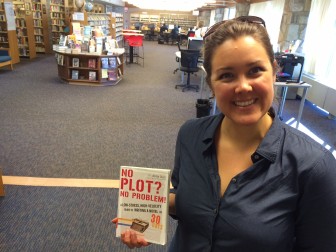November is National Novel Writing Month—a coordinated, structured effort that helps active and aspiring writers create their books on a demanding, 30-day schedule. At New Canaan Library, past “NaNoWriMo” participant and library staffer Erinn Paige has helped put together a series of interactive, supportive and relevant programs that tie into the larger novel-writing effort (you can see them here). We put some questions to Paige about her own writing experience with NaNoWriMo, and how she as programming library developed the events. Here’s our exchange.

New Canaan Library Programming Librarian Erinn Paige is helping to lead the National Novel Writing Month—”NaNoWriMo”—events at the library. Credit: Michael Dinan
New Canaanite: It seems like part of what National Novel Writing Month—”NaNoWriMo”—tries to do, is to create a supportive, interactive, accountable platform for what appears to be a rather solitary, personal endeavor: writing a book. What’s your approach as programming librarian in mapping out events that will stimulate creativity and support NaNoWriMo?
Erinn Paige: What I tried to do in creating our calendar was to consider the basic components of writing a book, which I’ve done a few times myself. There’s a research and planning stage (which often involves learning new tools) and a butt-in-chair writing stage in addition to an ongoing engagement with literature and craft.
To that end, we hosted a NaNoPrep workshop that looked at organizing research and notes for long-form projects like a NaNoWriMo novel using Evernote. We will also have a drop-in design workshop where people can learn some tips and tricks for designing covers.
Of course, we’re hosting a series of Write-Ins where much of the actual writing of NaNoWriMo will take place, and we tried to hold them at different times through the week so folks can join us as fits their schedule.
We’re also hosting some craft workshops for Teens and Adults, including a forum on memoir on November 13th (and yes! NaNoWriMo is often used for other long-form projects, not just novels).
How do your own experience as a NaNoWriMo participant, and your ideas about libraries as spelled out in one of your own books, “The Artist’s Library,” figure into the process [of mapping out those events]?
I think a lot of libraries that host Write-Ins during November only focus on the butt-in-chair part of the writing process. And that’s totally fine—there’s a lot to be said for supporting a community of writers in this way, by giving them a place to do something solitary together.
But if my experience as both a writer and a librarian—and the work of the Library as Incubator Project—has taught me anything, it’s that the library can support every step of the creative process. I wanted to approach NaNoWriMo holistically as a sort of microcosm of the writing process, and I wanted our calendar to reflect that. I wanted our NaNoWriMo events to demonstrate that we’re here to support the work of writers (and all artists) from beginning to end, not just when their book ends up on the shelf.
Talk to us about your experience with NaNoWriMo. What’s it like? What has come out of it for you?
I love NaNoWriMo. There are writers who see it as an amateur thing, and sort of silly, and I can see their point: if you’re a pro, 50,000 words in a month is not a challenge. But in the spirit of supporting the whole arc of the creative process, you start to consider the whole arc of a creative life–and sometimes, in the process of becoming a pro, you need the support of a crazy challenge to quiet your inner editor and shake loose the story inside you. Sometimes you need that even when you are a pro.
I had two books when I first “won” NaNoWriMo in 2013, but I had never written one particular story that had been rattling around in my head for almost ten years while I wrote other “worthier” things. NaNoWriMo was the excuse to get that story on paper, and it ended up being the thing that opened the floodgates for me. By the following year, I’d won a scholarship berth in Susanna Daniel’s Novel in a Year workshop with theMadison Writer’s Studio. That never would have happened without NaNoWriMo.
In your view, for someone who wants to get a taste for what this project can do: What’s the best book that has been published out of NaNoWriMo?
There are a ton! And some very surprising titles, I might add—Rainbow Rowell’s Fangirlbegan during NaNoWriMo 2011, and is one of my favorite books. I think learning that Sara Gruen’s Water for Elephants was a NaNo novel surprised me the most. Extensive lists of both traditionally published and self-published NaNo titles are fascinating to look through.
You’re dedicating some of what the library is putting on this month to teenagers, with teen write-ins and a writing group/club. What’s your message for a local teenager who is on the fence about participating in NaNoWriMo?
Try it. The wonderful thing about NaNoWriMo is that it’s not about making something perfect; it’s about unleashing potential. I think NaNoWriMo founder Chris Baty said it best in his book No Plot? No Problem! —
“The quickest, easiest way to produce something beautiful and lasting is to risk making something horribly crappy.”